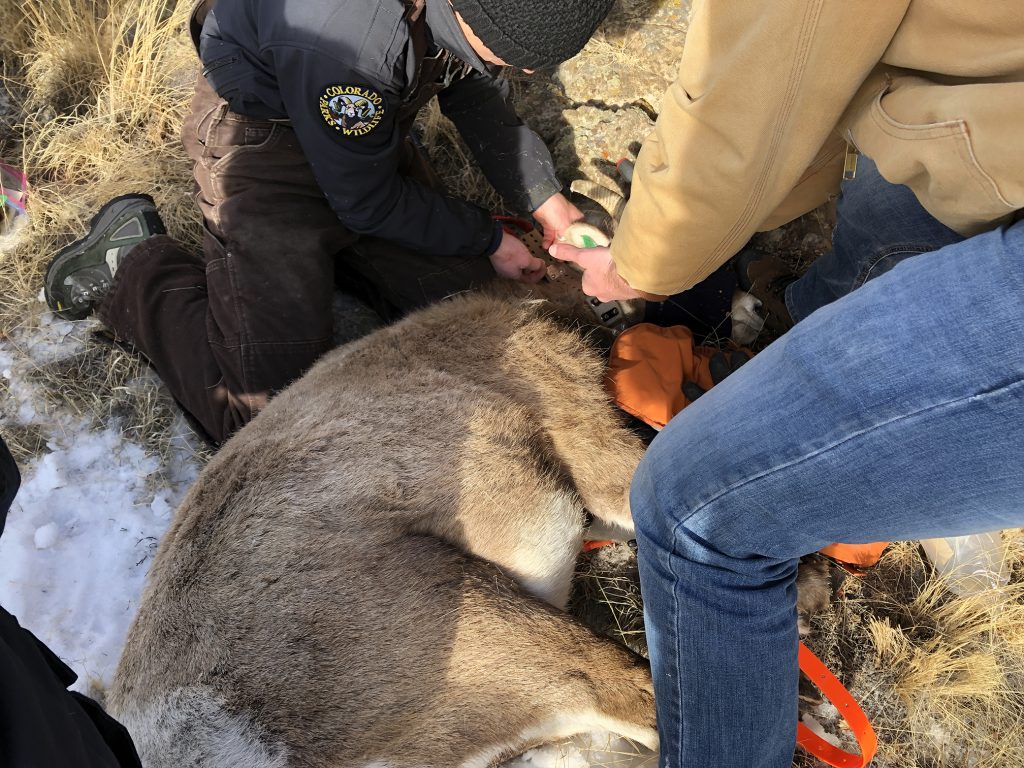DENVER – Colorado Parks and Wildlife biologists and officers are taking flight on a new project to examine the Tarryall-Kenosha Mountain bighorn sheep herd that at one time was one of the largest and most well-known herds in the country, but has since seen declines over the years.
Once abundant across western North America, historical estimates suggest bighorn populations were between 500,000 and two million animals prior to Anglo settlement. The Tarryall-Kenosha bighorn herd was at one time part of one of the largest bighorn herds with population estimates over 1,000.
Bighorn numbers across the west have dramatically declined. The same is true for the Tarryall-Kenosha herd located within the Pike National Forest and more specifically, the Lost Creek Wilderness. Multiple disease events over the last 70 years reduced herd population numbers through direct mortality and low success rates raising lambs. Today’s depressed population has not rebounded since the last disease epidemic between 1997-2000.
The project is one biologists are hoping will address three main objectives: 1 Seek to estimate population metrics including abundance and survival to help in assessing the population dynamics of the herd, and to evaluate causes of mortality in ewes and lambs.

(photo by Jason Clay/CPW)
- Identify factors limiting population recovery by assessing habitat characteristics, distribution and range use, predation rates, disease and herd health and possible human impacts.
- Use the data obtained to identify and implement management tools to improve the performance of the herd and apply that to other herds across the state. “This project will help us preserve the genetics of this iconic herd, which is crucial for bighorn management throughout the west,” said Shannon Schaller, Senior Terrestrial Biologist for CPW’s Northeast Region. “This herd has been the source for over 20 bighorn translocations that have helped re-establish populations throughout Colorado and beyond. The genetics of this herd are native to our state. We also hope to learn something about bighorn management that can be applied on a statewide level.”
Schaller initiated the project and obtained a $91,000 Auction-Raffle grant to be used for it. Wildlife biologist Kirstie Yeager is now setting the wheels in motion and managing the multi-year project that will use 30 GPS satellite collars to track and help obtain crucial data. To do so, it will require both a hands-on and an aerial approach.
“We will attempt to sample, mark and apply GPS collars on up to 30 ewes to help us assess the health of the animals and track them for several years,” Yeager said.
Capture work will be accomplished with helicopters and ground darting. Thirteen of the collars are already out with the first collars deployed on ewes on Jan. 3. Only ewes (adult females) will be collared in this project.
The remote nature some of these bighorns are located at makes it necessary to do capture work via helicopter. CPW is working in conjunction with the United States Forest Service and the U.S. Fish and Wildlife Service on this project to obtain the necessary approval for work in the wilderness area.
“The collars will last for three to four years, so ideally we should obtain beneficial data from several lambing seasons,” Yeager said. “Lambing is going to be one of the main things we are looking at to identify why recruitment into the population has been low, and we will track the lambs after they are born by following the collared ewes.
“Ewes will be monitored for survival, health and cause of mortality. GPS collars transmit a different signal when the collar stops moving, suggesting the animal may have died. We can then locate the ewe via signals transmitted by the collar, assess the cause of mortality and collect necessary samples.”
The Tarryall–Kenosha group has been classified by CPW as a Tier 1 population of greatest conservation need. By definition, Tier 1 groups are regarded as those large, native populations comprised of one or more interconnected herds that have received little, if any, supplemental releases in the past. These populations likely represent indigenous populations with the greatest genetic diversity who have been able to persist despite various adversities. Today in Colorado, the overall bighorn population is estimated to be approximately 7,000.
At least 28 percent of the estimated 375 animals in the Tarryall-Kenosha group were lost during the 1997-2000 disease outbreak. Another major die-off occurred back in 1952-53, which was the first documented, all-age disease-related die-offs in Colorado. It is believed that the pathogens were likely introduced by domestic livestock.
“Diseases can be a major limiting factor restricting population growth for Rocky Mountain bighorn sheep,” Schaller said. “Other factors such as habitat loss/fragmentation, human disturbance within critical habitats, road strikes and predation are other limiting factors for bighorn herds in Colorado. This project aims to identify limiting factors so we can implement management strategies to help recover the Tarryall-Kenosha herd and other bighorn herds across Colorado to repopulate Colorado’s state mammal across the Rocky Mountains.”
[VIDEO] Watch as the first GPS collars for this project get deployed
SPREAD THE NEWS
COMMENT, Like, Follow & SHARE @I70Scout
CURRENT EDITION
WEATHER & TRAFFIC PUZZLES RECENT NEWS ADVERTISE WITH US

